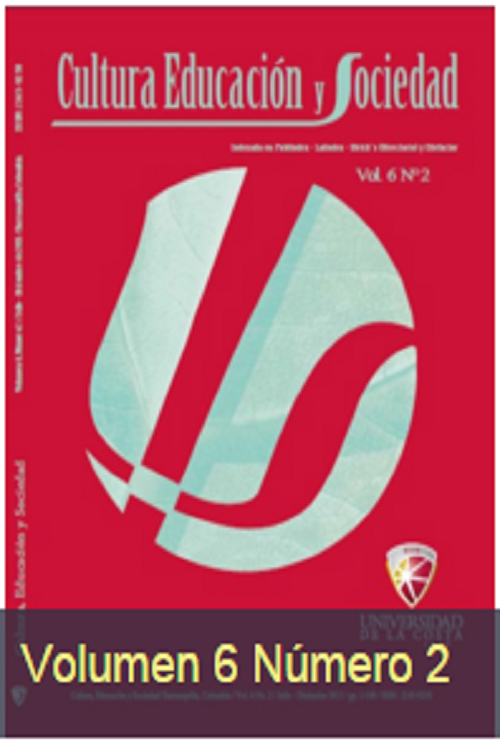The neuroinnovation of being an enhancer characteristic of social entrepreneurship
Keywords:
Neuro-innovation; human being; entrepreneurship; the social thingAbstract
In the global dynamism the multidisciplinariedad is studying pro-duct of the neurociencias, which has deserved the growth and wo-rry in the investigators of penetrating into the subject matter of the social neuroscience as discipline that it is born of the relation bet-ween the neurociencias and social psychology, in order to study the sciences of the conduct and the cognition. from the entrepreneurship of the human talent for the progress of the regions. For the above mentioned investigation the process of innovation joined departing from the capacity neuronal, and the social one as potenciadores from the emprendimiento. To this respect, the raised intention is Develar the of integration processes of the Neuroinnovación of the Being as characteristic potenciadora of the social emprendimiento. The the-matic areas were supported theoretically by authors as Soto, et al. (2015), Corradi and Jiménez (2014), Galvis (2014), Malagón (2013), Echeverría and Merino (2011), Amil and García (2010), Benito (2010), Grande-García (2009), Echeverría (2008), between others. Likewise, the methodology with a postpositivist paradigm was the qualitative approach, of documentary bibliographical type and it included an in-terview in depth of 2 informants. Between the obtained evidences was observed an integration enriched by the development of the cerebral capacities that do the most creative being and social entrepreneur in a global context which is argued in the development in an interpretive process of the investigated. Between the final considerations there were generated a few limits of substantive action, to help to extend the spectrum on the subject matter and to stimulate the deepening and continuation of this one event of so sensitive managing and im-portance nowadays from the entrepreneurship of the Being for the sustainable growth, diferenciador and ideally of the company.
Downloads
References
Alonso, L. & Fernández, C. (2011). La Innovación Social y el nuevo discurso del Management: Limitaciones y Alternativas. ARBOR Ciencia, Pensamiento y Cultura. 187(752). 1133- 1145. doi: 10.3989/arbor.2011.752n6009
Castro, L. (2014). Modelo de gestión Empresarial para micro y pequeñas empresas basadas en negocios Verdes. CAF Banco de desarrollo de América Latina.Panamá.
Comte, A. (1858). Positive Philosophy. Published by Calvin Blanchard, 76 Nassau Street.USA
Comisión Europea. (2015). Investigación Europea sobre neurociencias al servicio de la sociedad. doi: 10.2775/903957 .... Foro de la Sociedad Civil UE-CELAC (19-20 de marzo) Servicio de Información Comunitario sobre Investigación y Desarrollo. España.
Corradi, G. & Jiménez, J. (2014). Neurociencia y emprendedores. Blog Centro de investigación del Banco provincial. BBVA Innovation Center
Correa, A. (2008). Neurociencia aplicada: El cerebro al servicio de la humanidad. Departamento de Psicología Experimental y Fisiología del Comportamiento Universidad de Granada.
www.cienciacognitiva.org España.
Durkheim, E. (1986). Las reglas del método sociológico. Fondo de Cultura Económica.
Echeverría, J. (2008). El Manual de OSLO y la Innovación Social. ARBOR, Ciencia, Pensamiento y Cultura. doi:10.3989/arbor.2008.i732.210 CSIC. España.
Echeverría, J. & Merino, L. (2011). Cambio de paradigma en los estudios de innovación: El Giro social de las políticas europeas de innovación. ARBOR. Ciencia, Pensamiento y Cultura. Vol 187-752. doi: 10.3989/arbor.2011.752n6002. 1033. España.
Galvis, L. (2014). Neurociencia aplicada a la empresa. Oportunidades para el desarrollo de organizaciones Inteligentes y Sostenibles. Cámara de Comercio de Medellín. Colombia.
García-Albea, J. (2011). Usos y Abusos de lo “Neuro”.Resista de Neurología Pespectiva. doi: 10.1186/1744-859X-12-6. Universitat Rovira España.
Grande-García, I. (2009). Neurociencia social: El maridaje entre la psicología social y las neurociencias cognitivas. Revisión e introducción a una nueva disciplina. Revista Anales de Psicología. Volumen 25(1(). 1 -20. DOI:10.6018/analesps.28.2.147601 • 0.50 Impact Factor. Universidad Nacional Autónoma de México.México.
Guilford, J.P. (1983). Procesos del Pensamiento: El espiral creativo. Paidós. Volúmen 44. USA.
Hobhouse.L. (2010). Social Development Its Nature and Conditions. doi: • Available from: Maura Striano Routeledge Revivals.
Lorca, J. (2013). Construyendo La Innovación Social…desde abajo. Emancipación y Renacimiento 2.0. Editado por Julio Lorca. EEUU.
Malagón, F. (2013). El espíritu emprendedor y la creación de empresa. Escuela de Administración de Negocios. EAN, Google Académico. Bogotá D.C. Colombia.
Rocha, W. & Giraldo, G. (2015). Perfil del emprendedor de la ciudad de Valledupar. Universidad Popular del Cesar. Argos Grupo de investigación, Alpha& Omega. Colombia.
Ricaud, M., Maestre, M., Lemos, Tur, A. Ghiglione, M., A Samper, P. (2013), La influencia de la cultura en los estilos parentales en contextos de vulnerabilidad social. Scielo. Avances en Psicología Latinoamericana. Vol 31. (2). p/p 489-431. doi: 10.1111/j.1467-8624.2006.00963. Colombia.
Sahlins, M. (2013).Culture and Practical Reason.The University of Chicago Press. USA.
Silva, J. (2008). Emprendedor. Crear su propia empresa. Alfaomega Colombiana. Colombia.
Soto, M., De Pelekais, C., El Kadi. O. Newman, N. (2015).La creatividad del talento humano en la reinvención de las empresas. Encuentro de Creatividad, Innovación y Emprendimiento del Centro de Investigación en Ciencas Administrativas y Gerenciales. CICAG. URBE. Venezuela.
Spencer, H. (1958). Las inducciones de la sociología y las Instituciones Domésticas. . doi: 212 (1). Universidad Complutense. La española Moderna. España.
Torrance, E. (1984). Scoring and norms-thechnical manual for the streamlined scoring of the Torrance tests of creative thinking, figural forms A and B. Bensenville, Scholastic Testing Service. USA:
Downloads
Published
How to Cite
Issue
Section
License
Copyright (c) 2015 CULTURA EDUCACIÓN Y SOCIEDAD

This work is licensed under a Creative Commons Attribution-NonCommercial-NoDerivatives 4.0 International License.
![]()
Creative Commons 2020 CULTURA EDUCACIÓN Y SOCIEDAD
This article is under international license Creative Commons Reconocimiento-NoComercial-SinObrasDerivadas 4.0.
The published articles are the sole responsibility of their authors and do not necessarily reflect the opinions of the editorial committee.
CULTURA EDUCACIÓN Y SOCIEDAD respects the moral rights of its authors, who assign to the editorial committee the patrimonial rights of the published material. In turn, the authors inform that this work is unpublished and has not been previously published.
All articles are under a:
Licencia Creative Commons Atribución-NoComercial-SinDerivadas 4.0 Internacional.
![]()


 English
English
 Español (España)
Español (España)




_12.53_.27_p_. m_._3.png)





_12.57_.35_p_. m_._3.png)
_12.50_.37_p_. m_._3.png)



